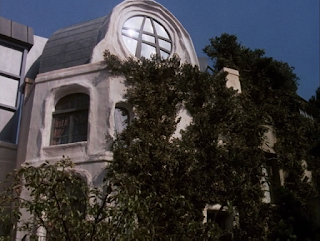The recent Marvel Extended Universe film of Ditko and
Lee’s classic hero was one of the better recent films for a genre that’s
dominated the last decade to the point of near exhaustion. You keep on thinking
it’s all going to come a cropper and then along comes Ant Man (most of it), Logan
and, especially Patty Jenkins’ triumphant Wonder
Woman which successfully recaptures the feeling of Richard Donner’s Superman whilst moving the genre boldly
in a new feminine direction: a hero becoming heroic and the impossible being
achieved through kindness and spirit.
Around the time of that original comic-book blockbuster
came many attempts to recreate this four-colour success on TV with Marvel
trying their hand at Spiderman and The Incredible Hulk with varying degrees
of success. Then came this oddity which four decades on I watched for the first
time having bunked off school and paid to see Spidey on the big – disappointing
– screen in the Liverpool Odeon – it was the TV pilot and not grand enough for
the scale.
 |
| The Fourth Dimension in the Seventies... |
Doctor Strange
is mild and entertaining in a predictable way – just like a comic book that
you’d keep as part of a series but one that wouldn’t get you started on a new
one: comic fans will like it because of our addiction to continuity and the
need to fill those holes in our collection. I have Green Lantern 1-300 and X-Men
1-300 but there are whole sequences I’d discard if only they wouldn’t leave
things so incomplete.
As if to prove this very point, this film was a pilot
produced with Stan Lee’s input that was designed to kick start the mage’s own
series but it obviously didn’t quite hit all the buttons unlike Hulk and DC’s Wonder Woman (there she goes again… never underestimate Princess
Diana of Themysciera!).
It’s only when you go back and read the early stories
scripted by Stan Lee and drawn by the magnificent Steve Ditko – the co-inventor
of Spiderman if you don’t know – that you realise just how odd Strange is.
There are stories of astral flight, alternative universes of inexplicable
dimensions and pure evil in continuous pursuit of our hero. This the recent
film captured, along with a precious sequence in which Benedict Cumberbatch’s
Doctor drives along to the sound of The Pink Floyd’s psychedelic classic Interstellar Overdrive (an early live
favourite featuring Syd Barrett’s improvisations years before the Dark Side…).
 |
| Sexy sorceress Jessica Walter |
But this film also kicks off in a strange dimension – the
Fourth - as our rather sexy baddy, Morgan Le Fay (Jessica Walter) is given one
last chance by the Demon Balzaroth (voiced by Ted Cassidy) to defeat the powers
of good magic who oppose all Demons and users of the dark-side of the dark
arts.
Morgan is convinced she’s the strength to beat the
reigning Sorcerer Supreme, the aging Lindmer (played by a perfectly-healthy
looking Sir John Mills), in spite of his always having beaten her in the past
and his ever-present trainee Wong (Clyde Kusatsu).
 |
| Eddie Benton gives Sir John Mills the push |
But Morgan is sneaky and she possesses the body of an
attractive young student, Clea Lake (“Eddie” Benton whose actual name was
Edmonda Benton, later Anne-Marie Martin and then Mrs Michael Crichton for a
while…), and gets her to push Lindmer off a bridge. Morgan leaves Clea’s mind
and the lass thinks she’s killed the old man but his powers are strong and he
wanders off with nary a speck of dust…
 |
| Peter Hooten and June Barrett |
 |
| Clea and the Doctor on the astral plane... |
Now things get complicated as even Morgan gets distracted
by the Strange good looks and, in a twist of (Doctor) fate his connection to Lindmer
is revealed after he appears at the hospital… Of course, Stephen has the
potential to be the next Sorcerer Supreme and Lindmer begins to help him along.
At Lindmer’s iconic Bleeker Street base (I’ve been there a number of times and
never seen it…) he enables Stephen to astrally project into the fourth
dimension and bring Clea’s soul back despite demons and dark magics ranged
against him.
 |
| Don't fall for her allure Doctor Strange! |
Dusty verdict:
A lot happens but there’s a strange (see what I did there…) absence of real peril
even though there’s flash bang and wallop – even a genuinely creepy scene with
Lindmer trapped, sunken-eyed in a mystical web of death… Philip DeGuere directs well but it’s just a little
tame especially with the tell-tale backlot exteriors, yet it is still entertaining at a comic book level and there's nothing wrong with that! I also liked his TV reference to Abbot and Costello as well as the moment when Stephen picks up a copy of The Hulk!
 |
| Sir John in his study |
 |
| Yep, she's called Eddie... |
So, of its time and all the better for it, a bridging
point between Steve and Stan’s masterwork and the MCU psychedelic revival and
well worth seeking out.
 |
| Bud and Lou on TV in Strange's office |





















































